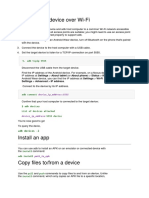0% found this document useful (0 votes)
42 views1 pageADB Commands and Details.
The document provides a list of ADB (Android Debug Bridge) commands for managing Android devices, including starting and killing the ADB server, rebooting devices, and accessing device information. It also covers commands for logging, updating apps, and retrieving device properties. Key functionalities include remounting partitions, checking device status, and executing shell commands on the device.
Uploaded by
kailasCopyright
© © All Rights Reserved
We take content rights seriously. If you suspect this is your content, claim it here.
Available Formats
Download as PDF, TXT or read online on Scribd
0% found this document useful (0 votes)
42 views1 pageADB Commands and Details.
The document provides a list of ADB (Android Debug Bridge) commands for managing Android devices, including starting and killing the ADB server, rebooting devices, and accessing device information. It also covers commands for logging, updating apps, and retrieving device properties. Key functionalities include remounting partitions, checking device status, and executing shell commands on the device.
Uploaded by
kailasCopyright
© © All Rights Reserved
We take content rights seriously. If you suspect this is your content, claim it here.
Available Formats
Download as PDF, TXT or read online on Scribd
/ 1






























































